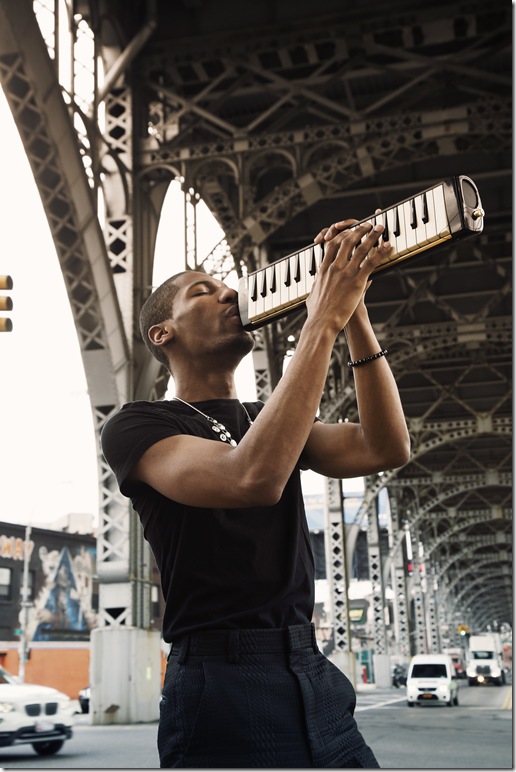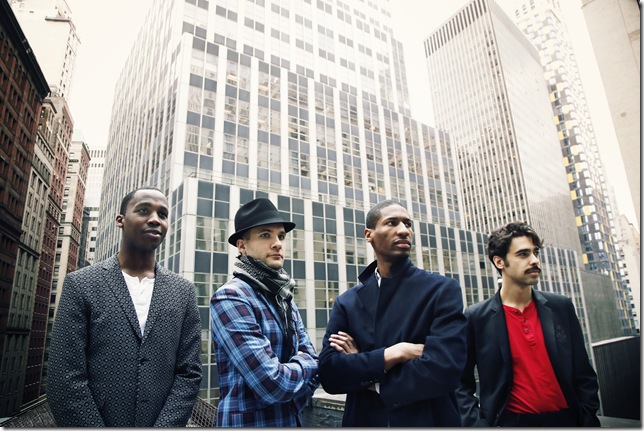The recently completed four-season HBO series Treme brought post-Hurricane Katrina New Orleans, and the city’s deep musical history, back into the spotlight.
Appearances by New York City-based jazz pianist and vocalist Jon Batiste also elevated the stylish young rising star a rung higher, something that’s no coincidence, since Treme was partly based on his own family’s Crescent City legacy.
His uncle, guitarist Paul Batiste, founded the Batiste Brothers Band in New Orleans in 1976. Jon’s father Michael Batiste is the group’s bassist, and the 27-year-old pianist has been one of 21 other family members who’ve joined them onstage at one time during festival appearances.
“I played with the family band quite a bit as a kid,” Batiste says from his tour bus while traveling between shows in Kansas City and St. Louis in mid-January. “It was the beginning of my exposure to music before I went off to school.”
For Batiste, school first meant the prestigious New Orleans Center for Creative Arts and then Juilliard in New York City, where he earned a master’s degree in jazz and classical piano. It was a brave new world for a young musician from a family of primarily self-taught players and singers.
“Uncle Paul studied, and is now an educator,” he says. “But I’m the only family member who went to a conservatory. And I received nothing but support when I went off to Juilliard.”
Batiste and his band Stay Human’s latest CD, the 2013 release Social Music (Razor and Tie), includes some of the classical undertones one might expect from conservatory products (alto saxophonist Eddie Barbash, tuba player Ibanda Ruhumbika and drummer Joe Saylor all attended Juilliard as well).
Yet Batiste, like many musicians of his generation, embraces transition as well as tradition. So in addition to flexing his classical chops on a solo bonus-track rendition of “The Star-Spangled Banner,” you’ll also hear him dueting with nature (the thunder on “D-Flat Movement”) and the voice of Jelly Roll Morton (“The Jazzman Speaks”), plus invoking Big Easy spirits through standards like John Hicks’ “Naima’s Love Song” and the classic “St. James Infirmary,” featuring Saylor’s take-no-prisoners drum solo.
The drummer also adds intermittent percussion parts throughout the CD; Barbash occasional high-register notes on alto that practically sound like a soprano (“He’s great at that,” Batiste says of the saxophonist, who also doubles on washboard), and Ruhumbika mimics a bottom end in the bass-free quartet while adding melodic nuances on both tuba and trombone. Even Batiste plays a second ax, the portable melodica (a hybrid keyboard and wind instrument), which factors heavily into the disc’s infectious track “Express Yourself.”
The idea to play melodica first came to him as a way to take music directly to people — difficult on an acoustic piano, which requires several people to even move across a room. After utilizing the newer instrument as a project at Juilliard, Batiste and company expanded upon the experiment to record a self-produced 2011 live EP, MY NY, on Manhattan’s subway system.
“We call those impromptu live performances ‘love riots,’” Batiste says, “and they’re always an adventure. ‘MY NY’ was recorded on subway cars for unsuspecting audiences that we had to win over.”
As the artistic director at large for the National Jazz Museum in Harlem, Batiste has won over students with a month-long programming course that taught them the history of jazz through the creation of a jazz video game. And his series Jazz Is: Now! has blurred any perceived lines between jazz and other musical genres by presenting artists like rock star Lenny Kravitz, Metropolitan Opera soprano Monica Yunus, and hip-hop drummer Questlove of The Roots in jazz settings.
Unlike another product of New Orleans, heralded trumpeter and bandleader Wynton Marsalis, Batiste believes there is much to be gained by going outside of only jazz and classical contexts. Social Music, in fact,fuses both of those time-honored traditional styles with found sounds and even occasional hip-hop elements. Imagine the sophistication of Duke Ellington and the genre-bending nature of Ray Charles, and you’re in the vicinity of Batiste’s musical social network.
“I’m a fan of all kinds of music happening in this era,” he says. “Conceptually, everything has something to offer, and I’m a hip-hop fan. I may not be a fan of all of the artists in the genre, but I can certainly appreciate the creativity.”
For the current tour, Batiste has expanded the core recording quartet in Stay Human (which has ranged from a trio to a big band since its inception eight years ago) to a live sextet. With additional creative instrumentation, naturally.
“We’ll be playing with Barry Stephenson on electric, acoustic upright and keyboard basses,” says Batiste, “plus Jamison Ross, a vocalist who plays percussion and laptop computer. Both of them are from Miami.”
On the final episode of Treme, Batiste played live with another standout product of New Orleans, trumpeter Nicholas Payton. The series was filled with cameos, including those by other Crescent City sons like pianist Ellis Marsalis (Wynton’s father), Trombone Shorty, and trumpeter Terence Blanchard. Treme’s musical mainstays, though, were actors Wendell Pierce (also from New Orleans) and New York City-born Clarke Peters. Pierce’s character, trombonist Antoine Batiste, even sported the esteemed family’s last name.
“Wendell doesn’t play trombone, but he definitely studied to make it look like he does,” Batiste says. “He’s a great guy. We used to hang out and talk in some New Orleans clubs that don’t exist anymore.”
Peters represented the musical culture of the Mardi Gras Indians as Albert “Big Chief” Lambreaux on Treme, and starred as Da Good Bishop Enoch Rouse in director Spike Lee’s 2012 religious drama Red Hook Summer (in which Batiste played the role of Da Organist T.K. Hazelton).
Batiste will also appear in Lee’s forthcoming 2014 film.
“Clarke is so great,” Batiste says, “and Spike really is something else. He hasn’t titled the new film yet because he doesn’t want to give away anything about it.”
Both the 47-year-old Pierce and 61-year-old Peters appeared in writer-producer David Simon’s Baltimore-based HBO police drama series The Wire (2002-2008) before he co-created Treme (2010-2013) with Eric Overmyer. The Washington, D.C.-born Simon didn’t have to venture too far from his native city to form the gritty The Wire, but Batiste is also impressed with what he envisioned on Treme.
“The film work, and especially ‘Treme,’ have spiked the number of people who recognize me now,” says the dapper bandleader and actor. “That series resonated with New Orleans culture, and brought renewed interest to the city, which can be very insular. So he’s obviously very good at capturing the essence of American cities. A lot more people know a lot more about New Orleans now because of ‘Treme.’ Everything in it might not have been completely accurate, but the vast majority of it was correct. And I wouldn’t have expected that from a guy who isn’t from there.”
See Jon Batiste and Stay Human at 8 p.m. on March 8 at the South Miami-Dade Cultural Arts Center, 10950 S.W. 211th St., Cutler Bay (786-573-5300, $25-46), and at 7:30 p.m. on March 11 at the Rinker Playhouse at the Kravis Center, 701 Okeechobee Blvd., West Palm Beach (561-832-7469, $28).

